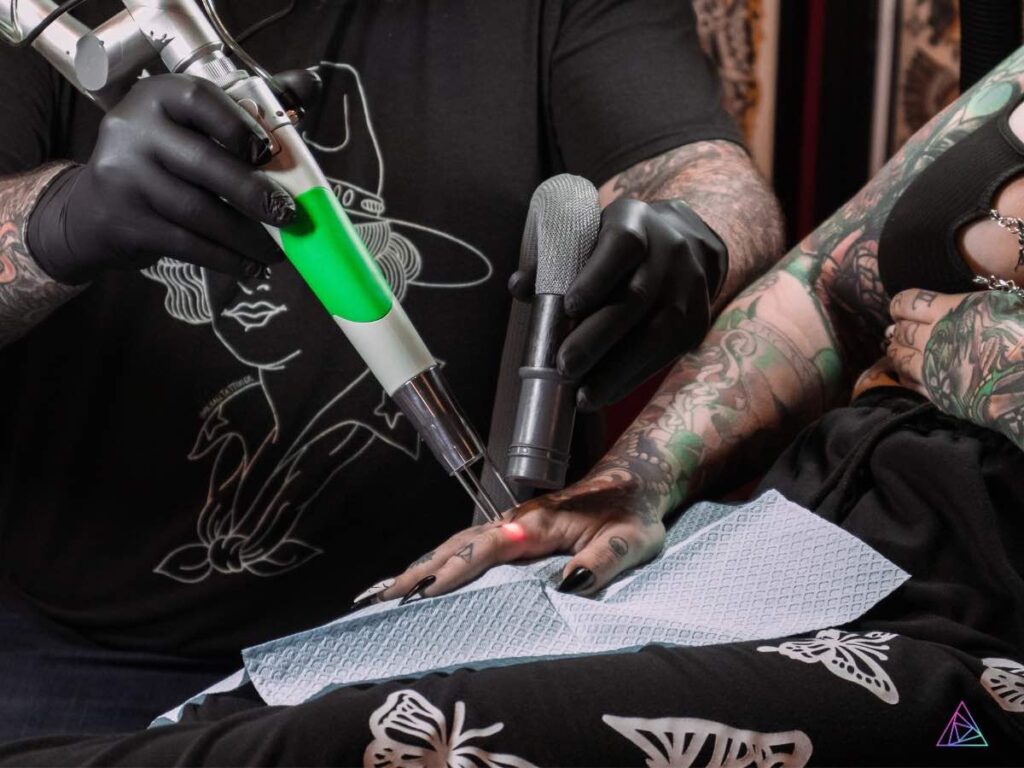Watching a tattoo removal video shows how a laser device appears to operate on the skin, but how does it actually work? You may wonder what’s inside the laser machine that creates the capability to fully remove or fade down any tattoo or correct other pigmentation concerns. Q-switched Nd:YAG lasers are the most common type of laser device for tattoo removal, but not all lasers are created equally. From wavelengths to power and energy, understanding the differences in FDA-cleared, medical-grade tattoo removal lasers is important for practitioners and aesthetic laser business owners.
Q-Switched Laser Devices
The term “Q-Switch” refers to the type of pulse created by the laser. While other lasers may be more familiar, such as laser pointers that create one continuous laser beam, Q-switched laser devices make laser beam pulses that last mere billionths to even trillionths of a second. Because the laser energy is emitted in such a short period, it’s concentrated into very powerful pulses. These powerful, short pulses have two significant benefits.
One: These quick and concentrated pulses are powerful enough to shatter tattoo ink and other pigmentation concerns into tiny particles that the body’s immune system can naturally process and flush out. Two: Because the energy from the laser is in the skin for mere nanoseconds (or even shorter in picoseconds when using pico laser machines), the surrounding tissue is not harmed. Only the tattoo ink or targeted pigment heats up and shatters, leaving the rest of the skin unaffected. If you fire the laser on non-tattooed skin, your patient won’t feel anything because the laser only targets and reacts to tattoo ink.
Nd:YAG and Ruby Lasers
About 90% of tattoos have black, brown, and gray ink colors. As a laser tattoo removal practitioner, it’s vital you invest in a suitable laser machine that can service your potential customers, their skin types, and their needs. If you know that most of your clients need black, brown, gray, and other dark-colored tattoos removed, then you’ll need to purchase a Q-Switched Nd:YAG laser that has both 1064 nm and 532 nm wavelengths.
The Astanza Duality tattoo removal machine is an advanced Q-Switched, Nd:YAG laser that uses these two wavelengths to safely and effectively remove tattoos that have black, brown, red, orange, and some dark purples, greens, and blues. The Astanza Duality uses a micro-lens array with a homogenized flat-top beam creating a powerful, uniform distribution across the skin’s surface for effective tattoo removal of these darker colors.
For the more uniquely colored tattoos like light blues, vibrant greens, yellows, and other light or pastel colors, a third wavelength is required for tattoo removal: 694 nm. The EternityTSR is a Q-Switched Ruby laser that precisely targets and shatters even the most vivid blue and green tattoo inks thanks to this unique wavelength.
Three Wavelengths Necessary for Full-Color Spectrum Tattoo Removal
When combining the 1064 nm and 532 nm wavelengths with the additional 694 nm wavelength, tattoo removal practitioners can safely treat any tattoo – regardless of the ink color. As the popularity of tattoos continues to rise, more tattoos will feature these unique colors, like blues, greens, teals, and yellows. And of the nearly 30% of Americans who have tattoos, about 23% of that population ends up experiencing tattoo regret.
When researching tattoo removal lasers, consider these numbers when looking at your potential clientele and which laser device best fits your needs. Those ready to open a tattoo removal business can purchase the Astanza Trinity tattoo removal machine, which combines the Duality and Eternity devices, offering all three wavelengths for full-color spectrum tattoo removal: 1064 nm, 532 nm, and 694 nm.
When studying differences in tattoo removal machines, you’ll come across nanosecond and picosecond technology and different wavelengths. Most Q-switched Nd:YAG lasers utilize nanosecond technology and have a pulse duration equaling one billionth of a second. More advanced Q-switched picosecond lasers have a pulse duration equaling one trillionth of a second. Understanding the difference between nanosecond and picosecond technology is vital.
The Asclepion PicoStar®, backed by Astanza, is the most powerful picosecond laser available with maximum pulse durations of 400 picoseconds. If you want to use the best tattoo removal technology with the shortest pulse durations and treat all tattoo ink colors, purchasing the PicoStar® and the EternityTSR is a perfect choice.
Learn more about Astanza’s extensive product line, which consists of FDA-cleared, medical-grade aesthetic lasers, and the Astanza Experience by contacting us today. Our award-winning team is here to guide aesthetic laser businesses every step of the way.

